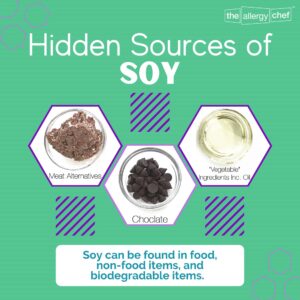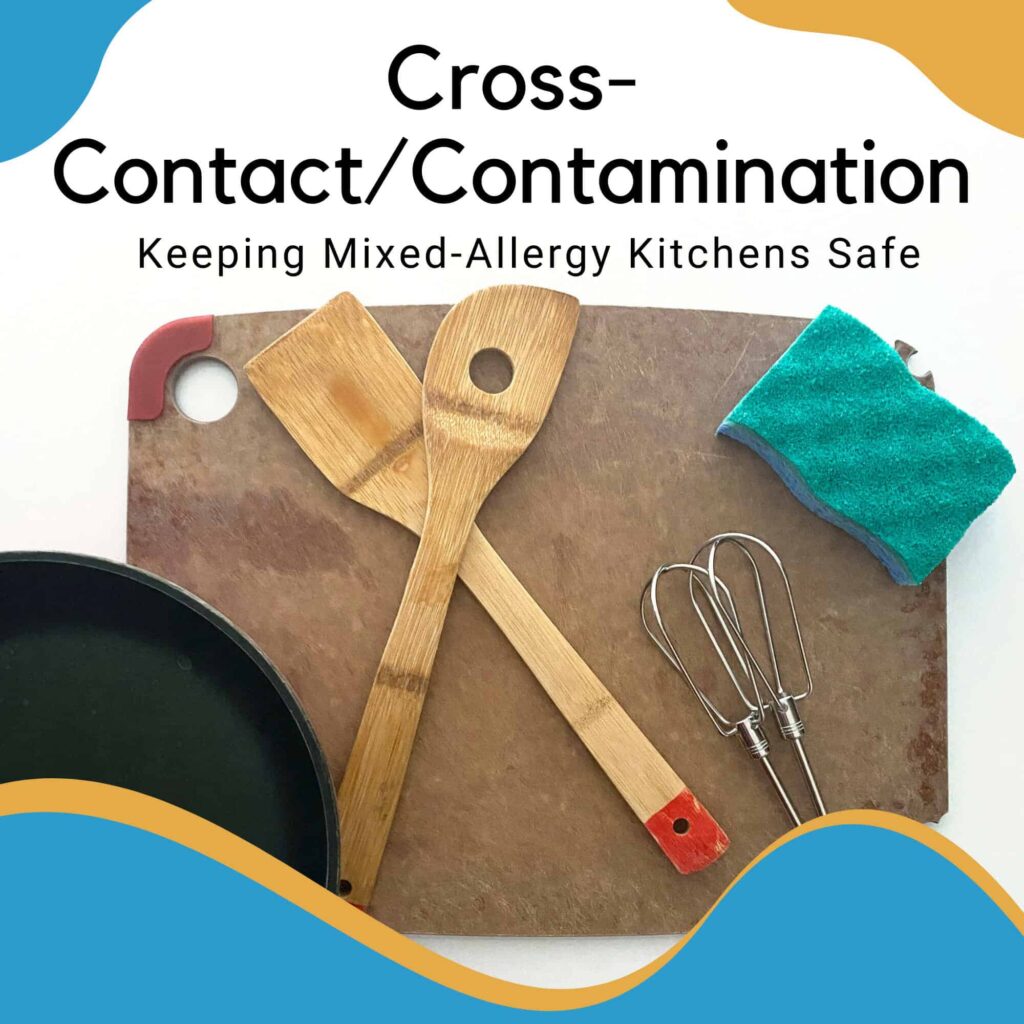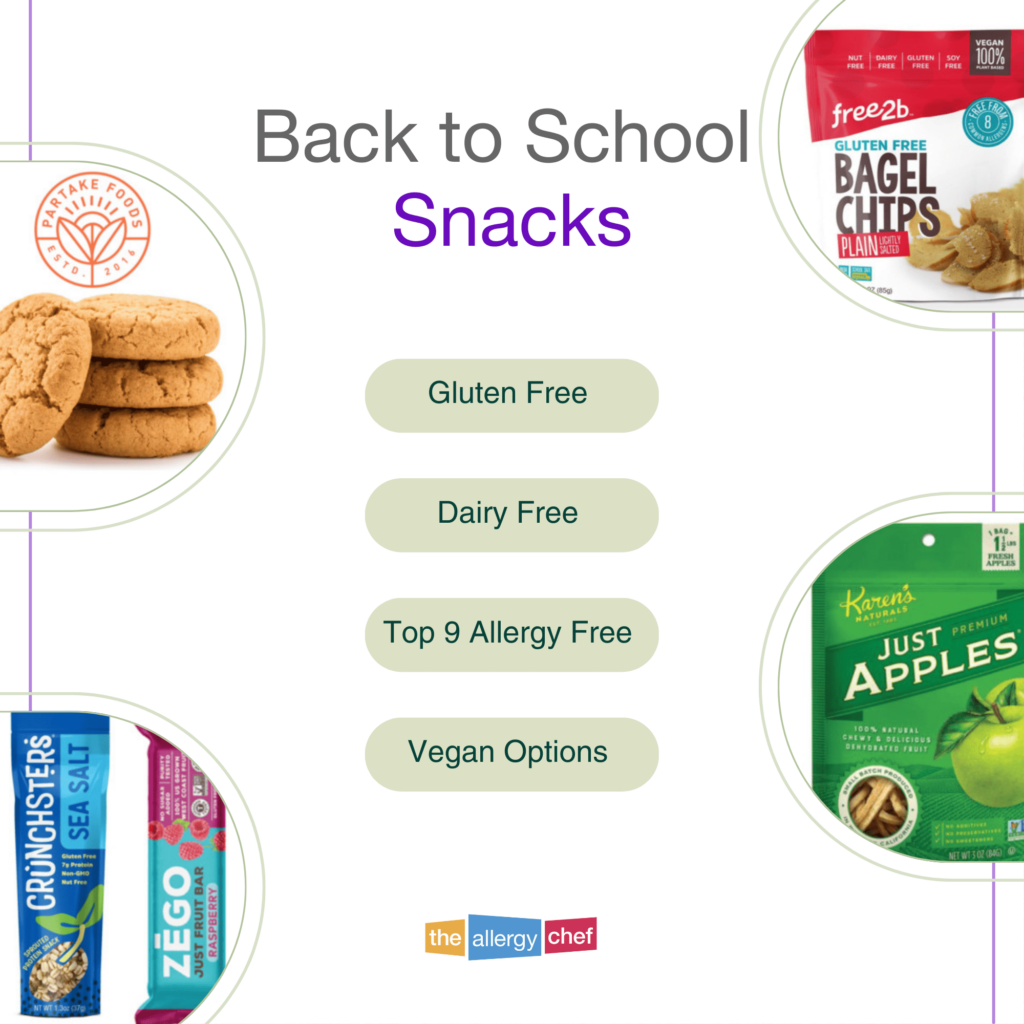Being diagnosed with any allergy is hard. H. A. R. D. However, I can tell you that a soy allergy (or corn allergy) diagnosis is truly the hardest to navigate. This is because soy and corn are in EVERYTHING including food and non-food items. Additionally, there are a lot of names for them that don’t sound like soy (or corn). Even though corn is more prevalent in the world, soy is doing its best to keep up.
Who would guess that many printers (home and commercial) use soy-based inks. And did you know that some brake lines for cars are made with soy these days? It’s not to say that you’ll be eating your break lines, but for a mechanic with a contact allergy to soy, this could pose a problem, and it’s certainly not something that’s advertised.
So, let’s dive into all things soy allergy. We’ll look at what it means to be allergic to soy, then take a look at foods to avoid with a soy allergy. I’ll also share non-food products that contain soy so you can protect yourself and/or your children from hidden sources of soy.
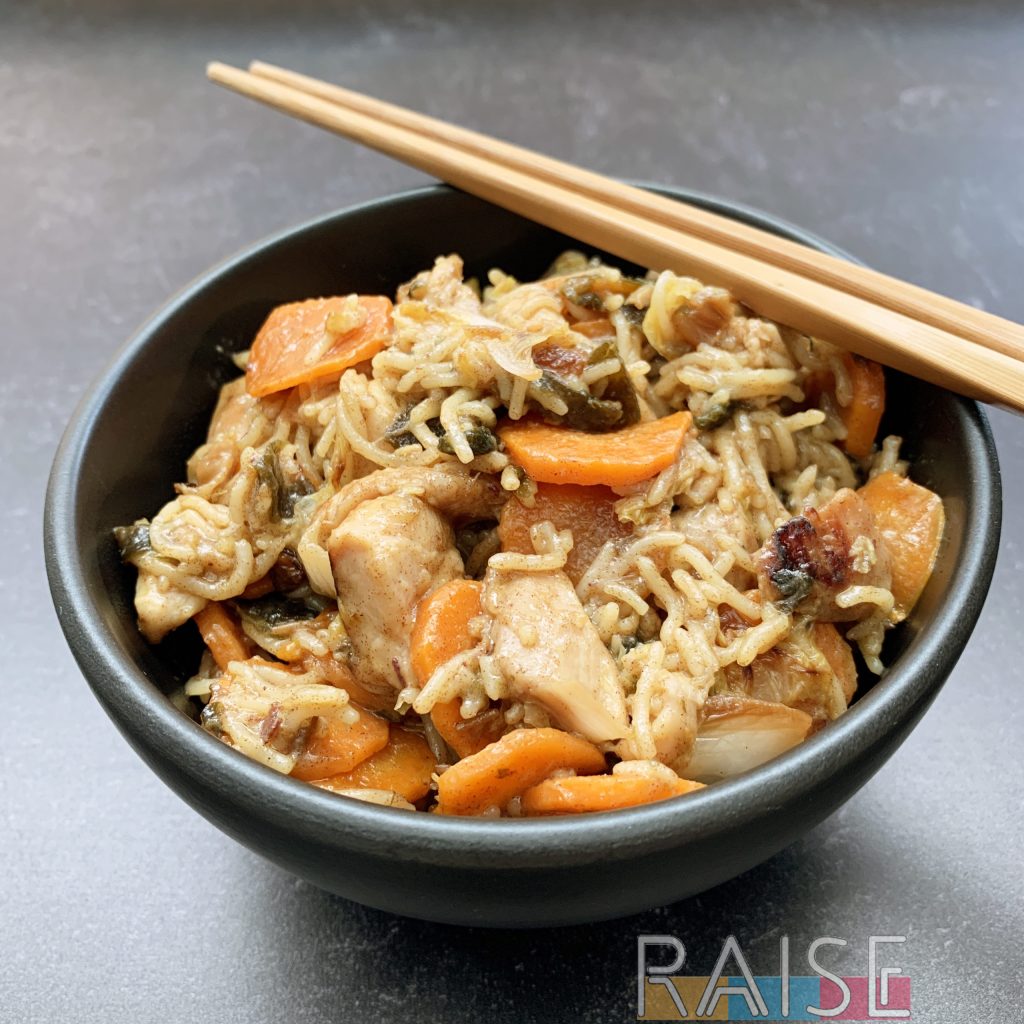
Some Soy Allergy Basics: Soy Is a Legume
- Soy is a legume native to East Asia.
- Soya, Soy, and Soybean, all refer to the same thing.
- Soy is commonly used in animal feed.
- Douchi is also called Chinese Fermented Black Beans. This is made from soybeans, not Black Turtle Beans which you may be familiar with.
What is a Food Allergy?
A food allergy is a response by your immune system that’s triggered by a protein that your body sees as a threat. This is not the same thing as a food intolerance or an autoimmune disease. If you suspect you have a food allergy, ask your healthcare provider to refer you to an allergist where a blood test and/or skin prick test can be ordered to determine if you have an allergy. Know that tests are not 100% accurate, but are still a good diagnostic tool.
A “true” food allergy is IgE mediated, and the immune system usually elicits a reaction within immediate ingestion to four hours. Outside of that window, it’s usually suspected that you have a food intolerance.
However, there are some types of allergenic diseases that are “true” food allergies and the reactions happen outside of the four hour window. Additionally, a person can have a more rare or complex case and suffer from delayed reactions (which can still be “true” food allergies).
In some patients, they have what’s called contact or airborne allergies as well. In their case, a reaction can be triggered by touching the food or by breathing in its particles (like when cooking or baking). Food allergies can be life threatening and should always be taken seriously. Work with your allergist and healthcare providers to create an action plan that will meet your needs.
Symptoms of a Soy Allergy
Food allergy reactions can vary among patients, as no two people are the same. Some allergy symptoms of a soy allergy include: diarrhea, blood in stool, dizziness, shortness of breath, difficulty breathing, wheezing, swelling of the mouth, tongue swelling, itchy mouth/throat, vomiting, hives, nausea, decreased blood pressure, racing heart rate, and more.
There are hundreds of symptoms a person can experience, but it’s important to know three things:
- Not every reaction is anaphylaxis. People can have “Non-traditional” reactions to food and still be allergic to them.
- Should a person experience anaphylaxis, it’s important to seek immediate medical treatment (use your epinephrine injector if you have one). When left untreated, anaphylaxis can lead to anaphylactic shock, which can cause death.
- Previous allergic reactions don’t predict future reactions (or the severity), and in some patients, continued exposure to allergens can cause more severe reactions each time.
A child may talk about a food allergy differently than adults. Many children will say things like “my mouth is spicy” or “there’s a frog in my throat”. They’re trying to express what the reactions feel like to them with language or experiences that are familiar to them. Always take note of these types of statements from a child, as they can indicate a serious medical situation. If needed, don’t hesitate to seek medical treatment.
Do You Have a Soy Issue or GMO Issue
If you do a little digging online, you’ll read about how some people love soy, and how others stay away. It has to do with HOW soy is processed, especially in the United States. I generally only purchase properly fermented soy products for my kids, and exclude as much processed soy as possible.
In the world of gluten intolerance and soy intolerance (not allergy) some people are actually reacting to the GMO element of the product and/or the pesticides used to grow these crops. Again, intolerance, not allergy. For some, when they switch to the organic version, all of their symptoms clear up. I want to make sure that you’re aware of this connection if you have a soy intolerance.
Should you fall into this category, also make sure you’re keeping a detailed food journal as you move through food trials so your medical team can help you assess. GMO soy being everywhere, and I encourage you to do some research on the topic and decide what feels right for your home.
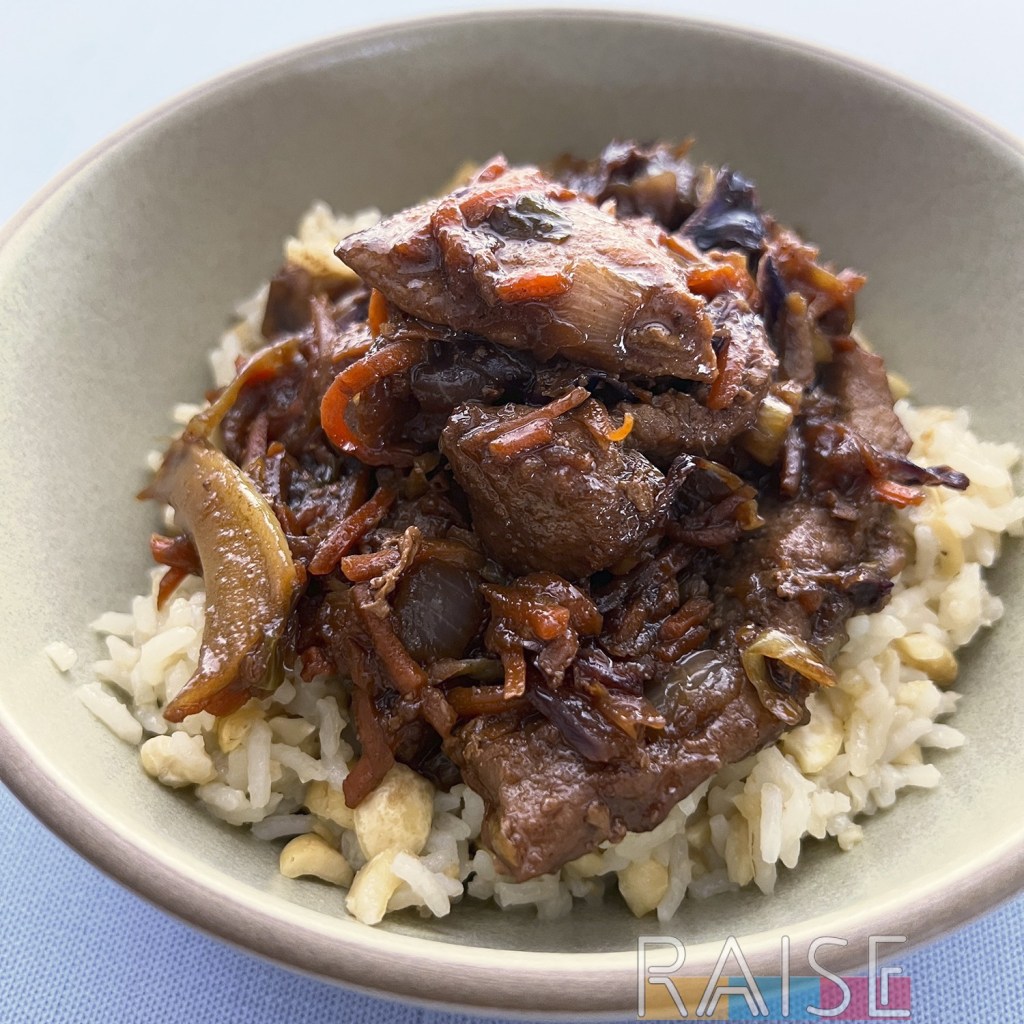
Cross-Contact: What Is It?
Cross-contact, which some people incorrectly but also technically correctly call cross-contamination, is something everyone with a food allergy needs to know about. It’s important that you use the terms that are used in the food service and food manufacturing worlds, not how you’ll see people use it on the internet. If you don’t use it properly then try to communicate, professionals will be confused.
Cross-Contact: This refers to allergens specifically. If a chef uses a spoon in the sauce containing soy, then transfers the spoon to the soy free sauce to sample. In this case, a pathogen was not transferred because the sauce is cooked. An allergenic protein however was transferred.
Cross-Contamination: This refers to pathogens, bacteria, and food borne illnesses.
Example: a chef places raw chicken on a cutting board to prep it for service. After completion, raw celery which will be served raw is placed on the same cutting board. There’s contamination from the raw chicken and can cause a food borne illness via the celery that touched the board.
The issue with these terms is that *technically*, cross-contact is indeed cross-contamination. If you eat something contaminated with soy, it causes a food borne illness in you. Yet, that’s where we have to focus on the terms pathogen and allergen. That will be the defining feature of these cross terms.
Now that you know the difference, make sure you use the right term when you communicate with companies and restaurants. Chefs and wait-staff especially will be confused if you use the wrong terms because they’ve been trained with pathogen vs allergen.
Through my work, I’ve met tens of thousands of people with food allergies. Whilst this isn’t an officially stat, I’m able to estimate that about 30% of people with food allergies aren’t able to eat food that’s been made on shared equipment with what they’re allergic to. Keep that in the back of your mind if you seem to have “random reactions” even though you’re following a soy free diet (but still eating commercially produced foods).
If you’d like to read a lot more about cross-contact, all the ways it can happen, and how to prevent in your own home, check out this article.
How to Read Food Labels When You Have a Soy Allergy
Soy is considered a major allergen here in the U.S. and around the world (top 8, top 9, top 10, top 12, and top 14). Food labels should clearly indicate if soy is an ingredient on the ingredient list of the package. You’ll either see the word soy in bold on the label, or you’ll see a “contains” statement. It will say something like “Contains: Milk, Soy“.
Here in the U.S. there’s essentially a loophole in the food labeling law that allows for highly refined soy oil to not be declared in the contains statement. If you cannot eat soy in any form or amount (highly refined or not), you’re going to have to read every single label extra carefully. It’s easy for the eyes to gloss over what’s on a label, so be sure to use a finger to guide your eyes along the words.
There are also things such as processing aids and shared equipment that don’t have to be disclosed on a label. The only way to usually get this information is to contact companies. Make sure you’re being specific with your questions, and don’t forget to ask about highly refined soy oil.
I suggest printing out the list of items in this article that refer to hidden soy and keep that in your car so when you go grocery shopping you can refer to it as needed. This can be especially helpful if you’re new to managing a soy allergy.
Other Names For Soy
In addition to the hidden sources of soy that we’ll cover next, there are several names of soy ingredients to lookout for. When you see these names, it indicates the presence of soy. These include:
- Edamame
- Miso
- Natto
- Soy Oil
- Soy Protein
- Soy Sauce
- Tamari
- Tempeh
- Tofu (sometimes called Yaki-Dofu)
Related: Best Substitute for Soy Sauce in Fried Rice
Hidden Sources of Soy
These foods and ingredients are what I would consider the very hidden sources of soy in terms of labeling:
- Bean Sprouts
- Guar Gum (can sometimes contain soy, varies by brand)
- Hydrolyzed Plant Protein
- Natural Flavoring (some compounds can be soy derived, so ask companies about this)
- Protein Powder (protein powders and isolates can often contain soy, especially in the vegan space)
- Sauces
- Vegetable Oil and/or Vegetable Shortening
I consider these rather hidden because their names don’t scream soy. Bean sprouts as an example could be referring to navy beans or soy beans. We don’t know until we look for a contains statement, or contact the company directly.
You’re also going to have soy in non-food items such as dog wipes. I was a little taken back when I read the label on one package and sure enough, there was soy.
For those who manage a contact allergy, it’s important that you know about the inks and packaging (including biodegradable) as well. Whilst this can be overwhelming when you’re new, the great news is that once you find your rhythm, managing your soy allergy gets MUCH easier.
Foods Where Soy is Often Used
These are foods that usually contain soy, and you may need to avoid these foods until you’re more comfortable with grocery shopping. If you see buzz words such as organic, non-GMO, vegan, dairy free, etc., soy can still be in the product. If you’re buying organic, it means they used organic soy in that particular product.
Additionally, some awesome companies like Rule Breaker go as far as to disclose if soy is used as a cover crop with any of the ingredients they source. Whilst most people won’t need that level of detail, it’s refreshing that someone is staying on top of these things.
- Asian Cuisine (especially as soy sauce)
- Baby Formula & Infant Formula
- Baked Goods
- Biodegradable Products (corn, soy, wheat, and sugar are the most commonly used raw materials)
- Bread & Breadcrumbs
- Cereals
- Chocolate
- Condiments
- Crackers
- Dairy Free Foods (Dairy Free Cream Cheese, Dairy Free Ice Cream, Dairy Free Yogurt, etc.)
- Dried Soy Bean Curd & Fresh Soy Curd (also called Yuba)
- Emulsifier (there are many types and soy can be one of them)
- Fried Foods (they can be fried in soy oil, or contain other soy derivatives)
- Lecithin (usually listed as soy lecithin, but can also be written as lecithin only)
- Marinades & Sauces for Meats and Vegetables
- Marshmallows
- Meat Alternatives
- Medications (doctors have access to a database to help determine if a medication contains soy and other allergens)
- MSG
- Peanut Free Foods (such as peanut free spreads)
- Plant-Based Foods
- Salad Dressing
- Seasoning/Flavoring Packets (think ramen packets, etc.)
- Snack Foods (Energy Bars, Chips, Cookies, etc.)
- Soy Eggs (these are eggs that have been marinaded in soy sauce)
- Soy Bean Flour (Soyabean Flour, Soy Flour)
- Soy Milk
- Soy Sauce
- Soy Sprouts
- Soy Yogurt
- Sweet & Sour Sauce
- Textured Vegetable Protein (also called TVP)
- Vegan Foods including Vegan Meat Substitutes, Vegan Tuna, and Vegan Sausages
- Vegetarian Protein Substitutes & Alternatives
- “Vegetable” Ingredients such as Vegetable Oil
Related: Soy Free School Snacks (GF + Top 9 Free)
More Hidden Sources of Soy: Non-Food Products That Use Soy
Like corn, soy has hundreds of uses in food, medicine, and agriculture. Since it’s a major allergen, it’s usually “easy” to get information about it in food. In non-food products however, there’s no regulation about allergen tracking. You’ll need to reach out to companies and specifically ask “are there any soy products, soy derivatives, or soy oil used in the manufacturing of XYZ”.
Most companies will have you talk with their Q&A department, or offer to look into it and get back to you. If a company can’t give you a straight answer, it may not be work the risk. Here’s a non-exhaustive list of non-food products that may contain soy (remember, it could contain corn instead):
- Anything BioDegradable
- Candles (when in doubt, purchase bees wax candles)
- Cast Iron Pans*
- Cosmetics (lotion, sunscreen, makeup, etc.)
- Dog Wipes
- Ink (think flyers, brochures, etc.)
- Medication
- Paint
- Pet Food
- Toothpaste
- Vitamin E Oil
- Vehicle Brake Lines
**About cast iron pans: it’s incredibly common for cast iron pans to be pre-seasoned with an oil, and it’s usually soy oil. This isn’t on the labels, and usually not on the manufacturer’s website either. The only way to find out is to contact a company directly. Even non-toxic and high end cast iron pans are pre-seasoned.
Personally, I opt for stainless steel (and love the Made In brand) to avoid this. You can also look into enameled cast iron pieces.
Have Hope!
I don’t want you to read this article and think all is lost. It’s the opposite in fact. First, knowledge is power. You can arm yourself with life saving information. Second, we’re living in a great time for food advancements. There are so many soy free foods and allergy friendly foods. You’ll have loads of options, even if you’re allergic to more than soy.
Third, you absolutely will live a full life and start to thrive. It’s hard in the beginning (like learning a new instrument). You’re going to have tough days, but then, you find your footing, get a great workflow going, find safe and delicious food, and live your life. You’ll look back and see that it’s manageable, and you’re making it.
Apps such as Spokin and Allergy Eats can be incredibly valuable tools The Fig app also has lots of praise from the free-from community.
Extra Helpful Resources for the Newly Diagnosed
- Free eCourse: Food Allergy Help 101: Hidden Allergens
- Free eCourse: Newly Diagnosed with Food Allergies & Food Intolerances
- Legacy Safe Products Lists & Guides on RAISE
- Soy Free Recipes on RAISE (membership website)
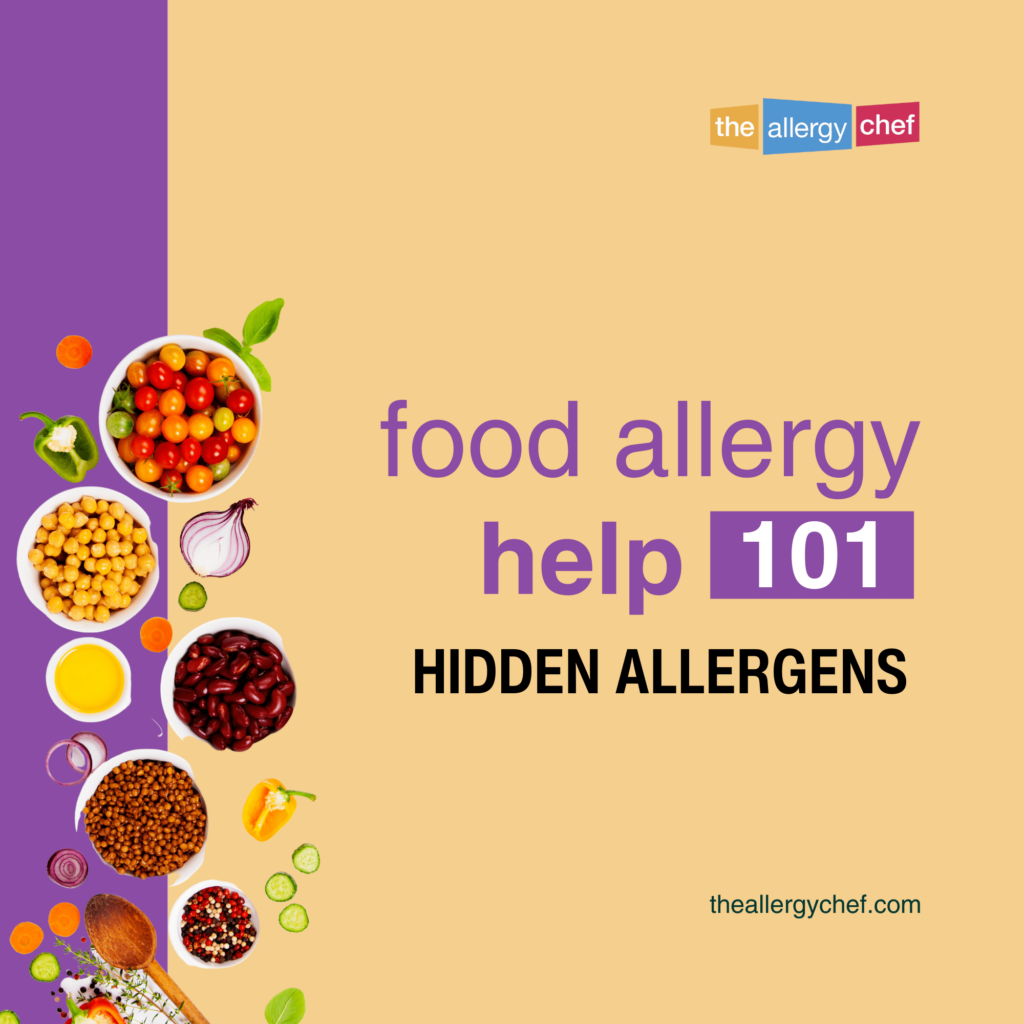 |
 |
The Final Soy Free Takeaway
You can see from the above list that basically, anything packaged and just about anything at a restaurant can contain soy. That doesn’t mean it will contain soy. Unlike other allergens such as egg, soy has SO MANY uses, and that fact can make it tough to avoid.
If you’re new to living soy free, you will benefit from consuming packaged goods that are advertised as top 9 allergy free. This means by default, there’s no soy in the product. However, if you have a severe allergy and cannot tolerate even trace amounts of soy, you’ll still need to call to find out about raw materials, processing, shared equipment, shared facility, etc.
Another option is to follow diet types that are naturally soy free such as Paleo and AIP Paleo. This can make finding recipes and products easier when you’re new to managing your food allergy.
If you find you’re struggling with packaged foods in general, shop the perimeter of the store, and check out the Whole 30 Diet. They focus on whole food ingredients rather than packaged items, and that can make cooking a lot easier for you at the start.
Answering Your Soy Allergy & Hidden Soy Questions
I Read That If I Have a Soy Allergy, I Can Still Have Soy Oil
First, no two people are the same. Many doctors and researchers feel that because with highly refined oils such as soybean oil and peanut oil, the proteins are “gone”, and therefore, and allergic reaction cannot occur. This is based on the definition of an IgE Allergic Reaction in its “Purest form”.
However, this is not true for everyone. Some people have reported they can have the oil whilst others have reported they have an allergic reaction. The same is true for people with peanut and/or corn allergies.
Interestingly, some doctors are convinced you can’t have an allergic reaction from airborne particles. Guess I’m wearing a full face respirator to leave the house, cook, and bake for nothing then… Annnnd that’s my point. No two people are the same. Many doctors are not quick to admit that the science hasn’t caught up to the real world on this one.
If you’re living with a severe allergy to something, it’s best to avoid it until you can work with a professional to determine if any form of consumption will be safe for you.
I’m starting a milk free, soy free, nut free diet. What type of milk substitute can I have?
You’ll want to look for seed based dairy free milk. The brand Good Karma Foods sells a flax milk that could work for you. There’s also banana milk, sesame milk, and rice milk that you can purchase commercially.
If you’re up for making milk at home, you could make tiger nut milk (tuber, not a tree nut, poorly named). The biggest tip I can give you though is to reach out to companies about shared equipment. Almost all commercial dairy free milk here in the US is made on shared equipment with other major allergens, including cow’s milk.
Is soy often found in soups?
It’s going to depend on the type of soup and the quality of the product. Soy is used in some soups as an additive or emulsifier etc., so make sure you’re reading food labels very carefully. I’ve seen soy in both organic and non-organic soups. You may even see soy in stew and chili depending on the brand.
Is soy a common ingredient in vegetable broth?
No, soy and soy derivatives aren’t commonly found in vegetable broth, chicken broth, or beef broth. However, you may find soy in bouillon cubes and similar products. Personally, I stick to organic (and grass fed where possible) bone broth. The ingredients are minimal, super clean, and there aren’t any questionable additives. I’ve personally never seen soy in any of the bone broth products I’ve purchased for my kids.
When managing milk and soy allergies, what type of cream cheese, cheese, and butter can I have?
Soy, wheat, and corn are the top food allergens found in the products you’re looking for. The good news is that there are a couple of brands that could work for you. Since you’re not allergic to tree nuts, you’ll want to look at these brands:
Those three brands have products such as dairy free cheese, dairy free cream cheese, dips, spreads, and even yogurt. For dairy free and soy free milk, check out the brand Malk. Whilst it’s a little on the pricey side, it’s one of the cleanest options available, which is something I prioritize. You may also like the brand Elmhurst, and my dairy free kid actually did a review on their products here.
Know that you’ll have quite a few options available to you. The easiest way to find said options, I’ve found, is to shop at organic/natural/Co-Op style grocery stores. They have a better selection of free-from products overall.
I’m allergic to soy. Does that mean I need to avoid peanuts as well?
Whilst there is a risk for a peanut allergy as well since both soy and peanut are in the legume family, there’s no guarantee that you’re also allergic to peanuts. The first thing you’ll want to do is ask your healthcare provider (or allergist) to test you for a peanut allergy. This will usually be done via skin prick test and/or blood test. Know that tests aren’t 100% accurate, but can still provide good insight.
Depending on the test results, an in-office oral food challenge may also be suggested by your doctor. Whilst you don’t have to do it if you’re uncomfortable, it can be an excellent diagnostic tool.
Know that there are lots of people that are only allergic to soy and not peanuts as well (and vice versa). I’d also suggest reading this article on a legume allergy which really dives deep into the topic of cross-reactivity.
Is soy a common additive in seasonings?
Here in the U.S. I haven’t seen used as a seasoning additive, but keep in mind, I stick to select brands. I have seen corn, especially as an anti-caking agent, but this can sometimes be derived from soy as well.
The top brand I can suggest for seasonings, dried herbs, and spices is Spicely Organics. They’re a top 8 allergy free company last I checked, and are super transparent about allergens. Additionally, if you have very specific questions, you can always reach out them and I’m sure they’d be happy to help.
What’s a good soy sauce substitute?
The best soy sauce substitute I can suggest will be coconut aminos. The taste isn’t quite the same, but coconut aminos offer a rich umami flavour. Another good option is a combination of mushroom powder and date paste. Put together, they lend themselves very well to a range of recipes.
Tamarind may be another good option to try. The taste is different, but you may enjoy the flavour profile it brings to the table. If you’re not allergic to fish, a good fish sauce can also provide a layer of rich umami flavour to your recipe.
Should I avoid all legumes if I’m allergic to soy?
Even though soy is part of the legume family alongside foods such as peas, beans, and lentils, you don’t necessarily need to avoid all legumes. Is there a risk of cross reactivity? Yes. Does it happen to everyone with a soy allergy? No. This article on a legume allergy is a great read as it further details the topic, and talks about how you can be allergic to one, some, or all legumes.
You should ask your healthcare provider about your individual risk for cross reactive reactions. Your allergist may also order further testing for you, and suggest an in-office oral food challenge. Remember, you don’t have to do a food challenge if you’re uncomfortable, but, it can be a great diagnostic tool.
Does a family history of food allergies mean my baby will have a food allergy as well?
No, a family history doesn’t guarantee that your child will also have a food allergy. It doesn’t exclude them either. Also know that even if both parents have food allergies (even to the same foods) and their child is born with food allergies, said child may not have the same allergies as the parents.

